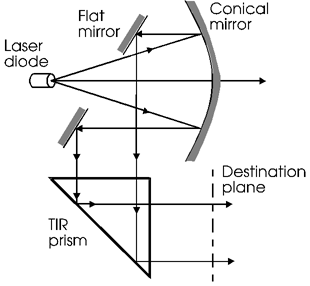
![]()
Optical System
Simulation Software
 |
|
|
Geometric-optical
ray tracing and wavefront This example shows some of the capabilities of the Ray_Trace option of DIFFRACT. Note, in particular, that the emerging beam at the destination plane is not just a collection of rays, but a fully reconstructed wavefront (i.e., amplitude and phase distributions).

The above diagram shows a system that has been simulated using the Ray_Trace option of DIFFRACT. The diode laser sends a diverging beam through the opening of the flat mirror. The beam is collimated by the parabolic mirror, and is redirected by the flat mirror towards the glass prism. Upon entering the prism, the beam suffers total internal reflection at the rear facet of the prism. It then re-emerges into the air, and is viewed at the observation plane. The intensity and phase plots for the components of polarization parallel and perpendicular to the polarization direction of the incident beam are shown below. The astigmatism of the beam (visible in the phase plots) is caused solely by the inherent astigmatism of the diode laser.
(left) Intensity pattern of X-component of polarization at the observation plane, and (right) phase pattern of X-component of polarization at the observation plane.
 
(left) Intensity
pattern of Y-component of polarization at the DIFFRACT allows you to convert wavefronts to geometric-optical rays, then trace these rays through your optical system. (The optical system may consist of an arbitrary number of lenses, mirrors, prisms, and apertures.) When ray tracing is complete, DIFFRACT will reconstruct the wavefront at the exit pupil, at which point beam propagation in diffraction mode may resume.
Home
| About MM Research, Inc. | Online
Publications © Copyright 1987-2011, MM Research, Inc. 5748 N. Camino del Conde, Tucson, Arizona 85718 |